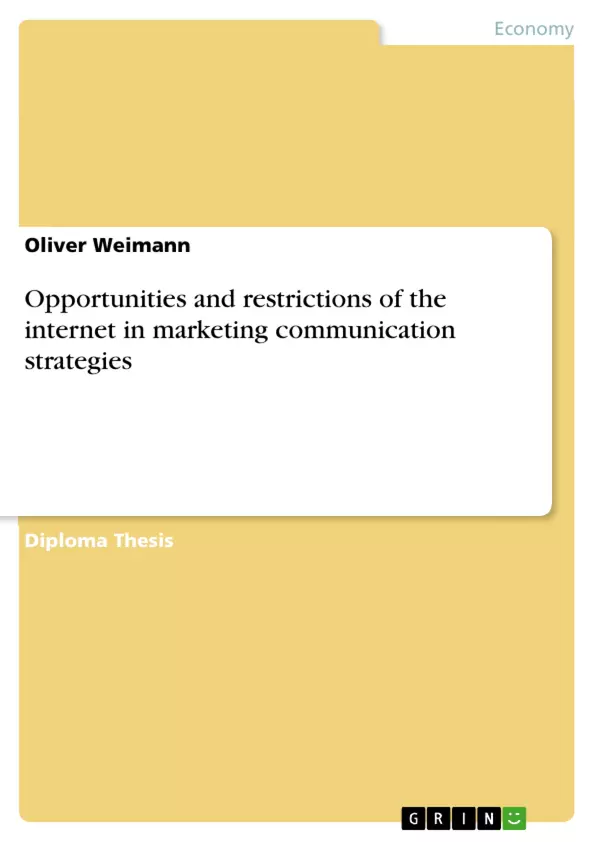This project should enable companies to understand the Internet and the possibilities, it offers to strategic marketing communication planning. Therefore it should finally outline in which way the services can be included in an Internet strategy and how it can be integrated in the company marketing strategy.
A short summary about the usage of the Internet and its services in marketing introduce this piece of work. The next chapter outlines the differences to classical media and delivers starting points for marketing communication. The main part should enable companies to develop a specific Internet marketing strategy to evaluate the opportunities and restrictions in praxis. A differentiation, not only between dot.coms and old economy companies, but also between big multinationals and SME's (Small and Medium Enterprises), was necessary because of different objectives, interventions, and not least of all, marketing budgets.
This work concentrates on the point of view of the marketer. Therefore technical aspects are only explained, if they are needed to understand the services and contexts. Included is Appendix I, which gives an overview of the Internet and its services, and Appendix II, which deals with marketing.
Finally, an overview of newly developed services and further development of the Internet will conclude this report. This will give a complete overview of Internet opportunities nowadays. That being said, it has to be taken into account that this report will probably be useful for not more then one to one and a half-years. This depends mainly on further developments of the Internet, which cannot be seen as a static system, but as a highly changing system with extremely short innovation cycles. To establish higher value, the discovered sources will enable further research for up-to-date information if this publication is no longer considered applicable to the topic.
Inhaltsverzeichnis (Table of Contents)
- 1. Introduction
- 1.1. Reasons for the Topic
- 1.2. Aims and Structure
- 2. Usage of the Internet in Marketing
- 2.1. Market Research on the Internet
- 2.2. Product Policy on the Internet
- 2.3. Price Policy on the Internet
- 2.4. Distribution Policy on the Internet
- 2.5. Conclusion
- 3. Communication Marketing at the Internet
- 3.1. Differences to classical Media
- 3.1.1. Interactivity
- 3.1.2. Multimedia
- 3.1.3. Hypertext
- 3.1.4. Virtual Worlds
- 3.1.5. Model of Communication for CME's
- 3.2. Starting Points for Communication Marketing
- 3.1. Differences to classical Media
- 4. Possibilities of Implication in the Communication Mix
- 4.1. Advertising
- 4.2. Fairs
- 4.3. Merchandising
- 4.4. Personal Sales
- 4.5. Product Placement
- 4.6. Public Relations
- 4.7. Sales Promotion
- 4.8. Sponsoring
- 5. Internet Marketing Strategy
- 5.1. The Branding Process
- 5.1.1. Creating Brand Awareness
- 5.1.2. Brand Experience
- 5.1.3. Brand Loyalty
- 5.2. Importance of Brand Loyalty on the Internet
- 5.3. Newly developed Marketing Strategies on the Internet
- 5.4. Negative Sanction
- 5.1. The Branding Process
- 6. Marketing Strategy
- 6.1. Changes in Organisational Structure
- 6.2. Integrating Internet Activities into Strategic Marketing Planing
- 6.3. The Branding Process
- 6.3.1. Creating Brand Awareness
- 6.3.2. Brand Experience
- 6.3.3. Brand Loyalty
- 7. Further Developments
Zielsetzung und Themenschwerpunkte (Objectives and Key Themes)
This project examines the opportunities and restrictions presented by the Internet within marketing communication strategies. The project aims to analyze how the Internet can be effectively used in different aspects of marketing, including market research, product policy, pricing, distribution, and communication. The project also seeks to identify specific strategies for integrating Internet activities into a comprehensive marketing plan.
- The Internet's role in marketing communication strategy
- Opportunities and restrictions of the Internet in marketing
- Effective use of the Internet in various marketing activities
- The impact of the Internet on branding and brand loyalty
- Strategies for integrating Internet activities into a comprehensive marketing plan
Zusammenfassung der Kapitel (Chapter Summaries)
- Chapter 1: Introduction - This chapter introduces the topic of the project, outlining the reasons for its selection and the aims and structure of the work.
- Chapter 2: Usage of the Internet in Marketing - This chapter explores how the Internet can be utilized in different aspects of marketing, including market research, product policy, pricing, and distribution. It examines the potential benefits and challenges associated with each area.
- Chapter 3: Communication Marketing at the Internet - This chapter analyzes the unique characteristics of communication marketing in the Internet environment. It delves into concepts such as interactivity, multimedia, hypertext, and virtual worlds, highlighting the differences between these aspects and traditional media.
- Chapter 4: Possibilities of Implication in the Communication Mix - This chapter examines the various elements of the communication mix and how the Internet can be utilized to implement each element effectively. It covers areas like advertising, fairs, merchandising, personal sales, product placement, public relations, sales promotion, and sponsoring.
- Chapter 5: Internet Marketing Strategy - This chapter focuses on the strategic aspects of Internet marketing. It explores the branding process, the importance of brand loyalty online, and newly developed Internet marketing strategies.
- Chapter 6: Marketing Strategy - This chapter discusses the broader implications of Internet marketing for overall marketing strategy. It covers changes in organizational structure, the integration of Internet activities into strategic planning, and the importance of the branding process in online marketing.
Schlüsselwörter (Keywords)
The primary focus of this project lies within the realm of Internet marketing, particularly examining the opportunities and limitations it presents for marketing communication strategies. Key areas investigated include market research, product policy, pricing, distribution, branding, brand loyalty, and the integration of Internet activities into a comprehensive marketing plan. The project analyzes the unique characteristics of online communication and explores the effective utilization of the Internet across various marketing elements, such as advertising, public relations, and sales promotion.
- Quote paper
- Oliver Weimann (Author), 2001, Opportunities and restrictions of the internet in marketing communication strategies, Munich, GRIN Verlag, https://www.grin.com/document/4533



